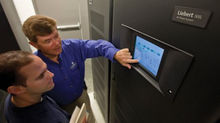Mission Critical Design Under the Scope
“Mission critical refers to any factor of a system (components, equipment, personnel, process, procedure, software, etc.) that is essential to business operation or to an organization. Failure or disruption of mission critical factors will result in serious impact on business operations or upon an organization, and even can cause social turmoil and catastrophes.”
Over the past few months we have highlighted common errors made in Control Room design. We followed up the series a couple weeks back with a post revealing examples of real life catastrophes that resulted from poor design. Now that we have broken down a myriad of defects in the control room design, we can begin speaking in more depth on each point to offer suggestions on how to properly design mission critical environments for the future.
But before we get into discussing solutions for Command Center Design, lets provide an overview of the talking points we have highlighted thus far.

Errors Within the Control Room
As we have noted multiple times, the common weak link in any Control Room is the “Human Factor.” As technology and industry continues to advance, less error will occur from software and equipment. We as humans will never be perfect and are prone to making mistakes. Therefore, we must continually create a working environment that helps reduce the probability of causing human error. Understanding the challenges effecting operators in the control room must be at the forefront of all control room design. From there, we can work backward and design according to equipment and spacing requirements. It is almost as if we take a backward to front design approach. But first it all starts with understanding common pain points.
Acoustics and Noise
When designing a Control Room, pain points such as “noise” are commonly overlooked in the concept phase. It is not until the room is already built, operators are in place, and the normal routine of the day is commencing, when noise as a pain point is realized.
Whether in the form foot traffic, conversation, cooling fans, and others, excess noise puts communication between operators and employees in the field at a much higher level of complexity. We dove into this concept in a little deeper detail with a previous blog found here.
Poor Lighting
During the design phase, lighting can be a very difficult task to combat in the efforts of supplying clear and apparent light. Whether it comes in the form of glare, low lighting etc… Mismanaged lighting can present a real problem for operators so dependent on reading their screens and video walls clearly. We cannot even begin to design the room with consoles until we understand how lighting will factor into the habitat of the room. A broader discussion can be found here.
Line of Sight
Potentially the most vital component to Control Room Design, is the line of sight between the operators and the systems they are monitoring. Imagine the control room as the heart and lifeblood of a facility. If there is a clot within any of the arteries, the transmission of blood flow and oxygen will be prevented causing vital organs to fail. The same can be said for a control room. If any one component goes down, the whole operation feels the effect. With such importance being placed on catching hazardous information in real time, sight lines must be at the forefront of every design with the most critical systems in plain view. Again, our post was shown here.
Traffic
Much like the traffic systems control rooms monitor, command centers require an uninterrupted focus. Consequently, every movement of a bystander presents an equal element of distraction within the room. The breakroom, the exit and all other avenues of transit are major factors inviting constant flow within the room. Minor as it may seem, we can speak in regard to negative outcomes resulting from poor traffic control for days. And although most will say, “it does not bother them,” or “we are used to it,” the reality is people can be easily distracted without recognizing the distraction as a threat. This was the last segment of our series, but only the beginning in the larger discussion to come. This post can be found here.
Dormant Activity/Ergonomics
When we minimize the room noise, eliminate distraction, improve lighting, sightlines and ergonomics, there seems to be nothing working against your operator/controller. Or is there? “With every action, there is an equal and opposite reaction.” A very curious quote that plays well with this concept. As we begin to resolve certain issues, we start creating a more comfortable environment that can potentially create a static environment with minimal occurrences keeping operators on their toes. What happens when the environment becomes too cozy and allows individuals to lose alertness? We must consider ergonomics into our design allowing operators the flexibility to remain healthy in their mental and physical presence. A great look into this concept can be found here.
Sum It Up
As we have seen there are many factors that play a significant role in proper Control Room Design. However, this only covers a fraction of the entirety in the design process. We have not touched on technology, equipment, power, and ergonomics as a whole. Of course we will get to each one as we begin breaking down the different layers in Control Room operations. Over the next few weeks we will conclude our series in “Designing Around the Human Factor,” offering insights how to properly design a Control Room with the errors referenced in mind. We will also begin tying in other factors, such as technology, that play a large role in the functionality of Control Room operations.
We aim to open dialogue around these topics, it is our hope that professionals around the industry continue to comment and offer their insight throughout these discussions. As always, we are more than available to anyone who would like to dive into deeper conversation around these concepts. If you have any questions, our full contact information can be found here, or you can reach me directly at Cwilson@legacydenver.com







